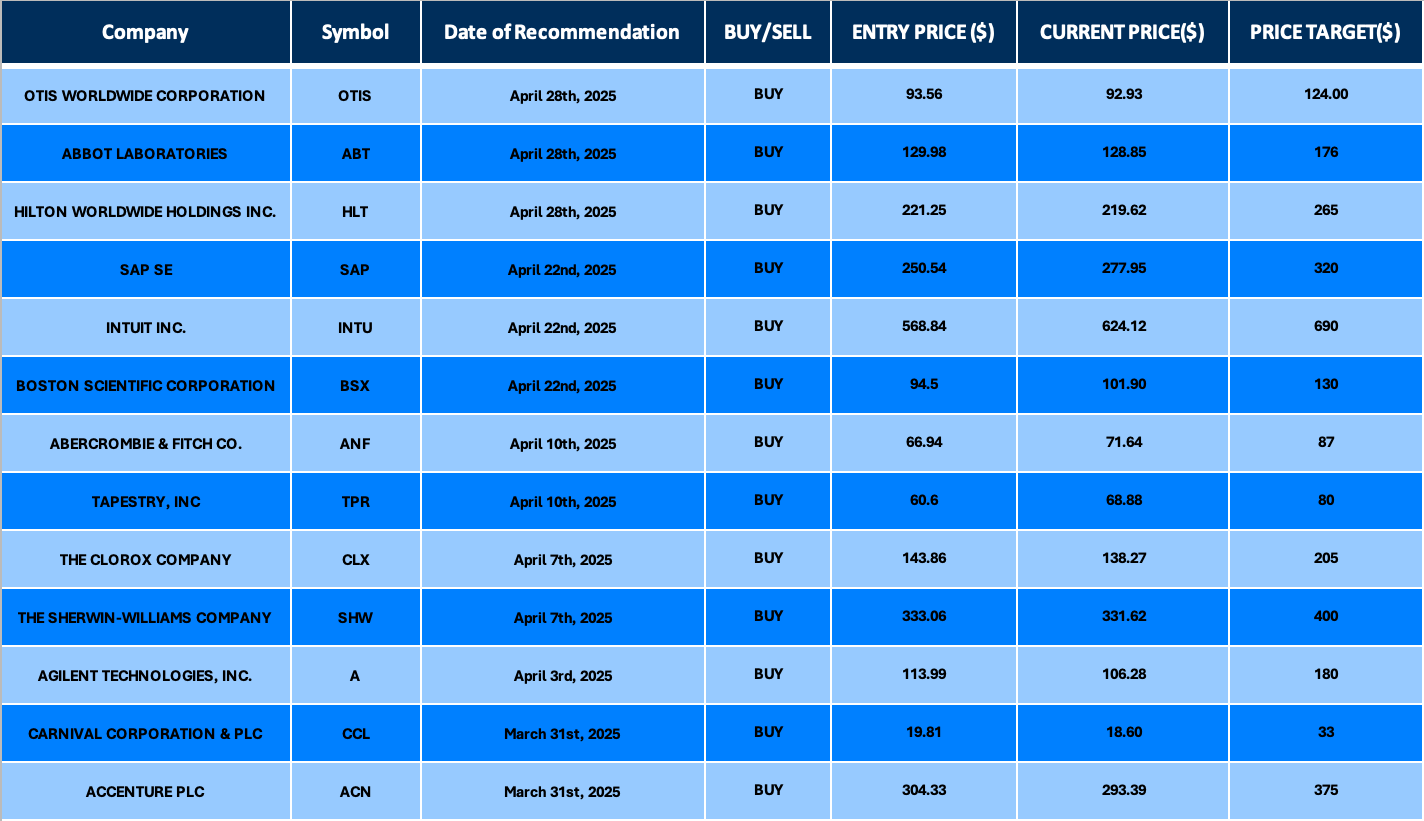
Date Issued – 16th May 2025
Preview
Markets opened Friday on a cautious note as optimism over a U.S.-China tariff truce faded under the weight of lingering economic uncertainty. U.S. futures were little changed, while Japanese GDP data disappointed and Walmart flagged inflationary pressures tied to tariffs. A Bloomberg survey revealed Trump-era tariffs on Chinese goods are likely to persist at 30% through late 2025, threatening export flows and dampening China’s growth outlook. Still, Barclays scrapped its U.S. recession forecast, lifting 2025 growth expectations to 0.5% amid improved trade sentiment. In equities, Richemont beat sales forecasts thanks to robust U.S. jewellery demand, offsetting weakness in Asia. Meanwhile, Coinbase shares tumbled after a $400 million data breach linked to bribed offshore agents, just days after the company joined the S&P 500. With macro signals mixed and geopolitical risks mounting, investors are rotating cautiously, favoring resilient sectors and monitoring sentiment and security developments closely.
Market Caution Returns as Trade Optimism Fades
U.S. equity futures hovered near flat early Friday, reflecting a cautious tone across global markets as investors digest conflicting economic signals. Futures on the Dow Jones Industrial Average rose 0.09%, while the S&P 500 was unchanged and Nasdaq 100 futures dipped 0.02%. Thursday’s trading was marked by muted gains eroded by concerns over the economic drag from President Trump’s tariffs, despite initial optimism from a partial rollback agreement with China. Walmart’s earnings underscored inflationary pressures, warning of “unavoidable” price hikes. Meanwhile, in Asia, markets traded mixed following a sharper-than-expected 0.7% annualized contraction in Japan’s Q1 GDP, casting doubt on regional growth momentum ahead of key economic releases. Investors are now eyeing the University of Michigan’s consumer sentiment data for further insight into domestic resilience.
Investment Insight: Despite temporary relief on the trade front, markets remain vulnerable to lingering tariff effects and softening economic data. Investors should maintain a defensive posture, prioritizing sectors resilient to inflation and geopolitical noise, while closely monitoring consumer sentiment as a leading indicator for broader spending trends.
Tariff Uncertainty Weighs on China Outlook as U.S. Maintains Pressure
Markets are bracing for prolonged trade tensions after a Bloomberg survey showed U.S. tariffs on Chinese goods are likely to remain at 30% through late 2025, despite the recent 90-day truce between Washington and Beijing. Analysts warn the elevated levies—significantly lower than peak levels but still punitive—could erase up to 70% of Chinese exports to the U.S. in the medium term. The survey underscores low expectations for substantial progress in negotiations before the 2026 U.S. midterm elections. Chinese industrial output is forecast to slow to 5.9% in April, down from 7.7% in March, with export softness and weakening factory activity already reflecting the tariff impact. While the yuan is expected to stabilize near 7.2 per dollar, Chinese equities and bond yields are seen trading in tight ranges as policy uncertainty tempers investor enthusiasm.
Investment Insight: Persistent tariff headwinds reinforce a cautious stance on Chinese assets, particularly in export-sensitive sectors. With limited scope for near-term policy easing and trade negotiations expected to yield only incremental progress, investors should favor companies with domestic demand exposure and structural growth drivers. Currency stability may offer some relief, but headline risk from U.S. trade policy remains a key volatility trigger through year-end.
Barclays Scraps U.S. Recession Call on Trade Truce Optimism
Barclays has reversed its U.S. recession forecast, citing easing U.S.-China trade tensions as a key driver of improved economic prospects. In a note released Thursday, the bank now anticipates U.S. GDP growth of 0.5% in 2025, compared to a prior projection of a 0.3% contraction. Growth for 2026 was also adjusted modestly higher to 1.6%. The more stable trade environment has also prompted upward revisions for the euro area, with Barclays now expecting flat growth in 2025 instead of a 0.2% decline. However, the bank maintains a cautious stance on Europe, forecasting a shallow technical recession in the second half of the year amid persistent uncertainty around U.S.-EU tariff negotiations.
Investment Insight: The shift in Barclays’ U.S. outlook underscores how pivotal trade sentiment remains for macro forecasts. While risks linger, especially in Europe, reduced recession probability in the U.S. supports a constructive stance on risk assets. Investors may consider selectively adding cyclical exposure while remaining hedged against geopolitical volatility and trade-related setbacks.
Richemont Sales Beat Forecasts as U.S. Jewellery Demand Offsets Asia Weakness
Richemont posted a 7% rise in Q4 sales, slightly ahead of expectations, driven by strong U.S. demand for high-end jewellery despite persistent weakness in Asia. The Swiss luxury group reported €5.17 billion ($5.80 billion) in revenue for the quarter ending March, with its jewellery division—home to Cartier and Van Cleef & Arpels—rising 11%. This helped cushion an 11% decline in watch sales, largely due to subdued demand in China amid ongoing property sector stress. While total growth slowed from 10% in the previous quarter, resilient spending by affluent American consumers provided a buffer against regional volatility.
Investment Insight: Richemont’s results highlight the diverging trajectories within the luxury space, with jewellery outperforming watches and the U.S. market proving more resilient than Asia. Investors should closely monitor regional exposure and category mix when evaluating luxury equities. Names with strong U.S. jewellery franchises may offer relative safety amid macro uncertainty and uneven global demand.
Market price: Campagnie Financière Richemont SA (CFR.SW): CHF 154.90

Coinbase Hack Undermines Crypto Mainstreaming Just Days After S&P 500 Debut
Coinbase shares plunged 7.2% Thursday after the crypto giant disclosed a major data breach that compromised sensitive customer information, casting a shadow over its recent addition to the S&P 500. Hackers reportedly bribed offshore customer service agents to access personal data—including IDs and banking details—for several high-net-worth users in a breach dating back to January. While Coinbase Prime, which handles institutional assets including ETF custody, was unaffected, the $400 million incident ranks among the largest in crypto history and raises fresh concerns around security in the digital asset space. The company is offering a $20 million bounty for information on the attackers and has pledged full reimbursement for affected users. Separately, news of a lingering SEC investigation into Coinbase’s historical user metrics added to market unease.
Investment Insight: The breach is a stark reminder of the persistent operational and reputational risks within the crypto sector—even for its most established players. While Coinbase’s core institutional services remain intact, the incident may slow institutional adoption and inflows into crypto-linked products. Investors should reassess cybersecurity exposure in digital asset holdings and brace for possible regulatory tightening as scrutiny intensifies.
Market price: Coinbase Global Inc (COIN): USD 244.44
Conclusion
As markets navigate a fragile recovery narrative, investor sentiment remains tethered to shifting trade dynamics, mixed economic data, and sector-specific stressors. While easing U.S.-China tensions provide a near-term lift to growth expectations, persistent tariff risks and geopolitical uncertainty continue to cloud the outlook. Corporate developments—from Richemont’s resilient jewellery sales to Coinbase’s security breach—underscore the importance of selectivity and risk management in portfolio positioning. With inflation signals, consumer sentiment, and regulatory scrutiny in focus, investors should stay nimble, emphasizing quality, defensiveness, and macro awareness as key themes heading into the second half of the year.
Upcoming Dates to Watch:
May 16th, 2025: Japan Industrial Production, Hong Kong GDP
Find below some of our Buy/Sell Recommendations. Balfour Capital Group is a distinguished global boutique investment management firm with $350 million AUM and over 1000 Clients.

Disclaimer: This post provides financial insights for informational purposes only. It does not constitute financial advice or recommendations for investment decisions.




